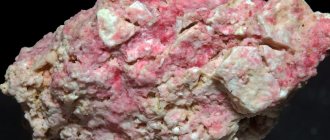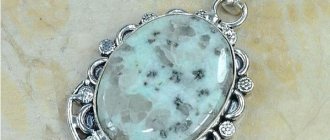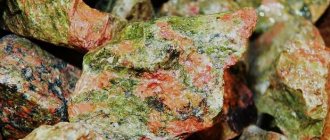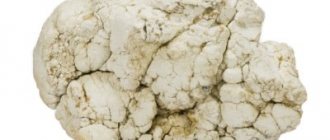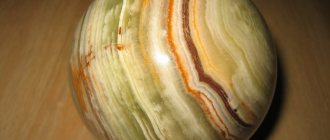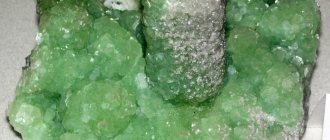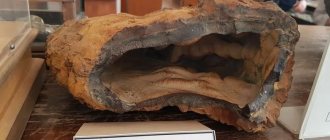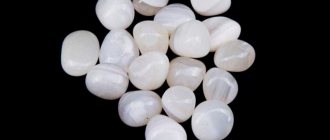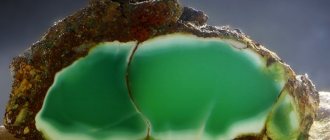- Properties
- Where can I buy
- Articles
Sylvanite is a mineral telluride of gold and silver. Chem. Theor. composition (at Ag : Au = 1 : 1): Au - 24.19; Ag - 13.22; Those - 62.59. The ratio Ag:Au = 1:1, sometimes Au slightly predominates.
In the crystal lattice of sylvanite, Te atoms are located almost along the same line with Au and Ag atoms in parallel (010), which determines the perfect cleavage of the mineral along (010). The Au, Ag, Te atoms are in sixfold coordination.
Main diagnostic signs Silvery-white color; light etching; low hardness; paragenesis.
Dims in bright light. HNO3 decomposes, releasing a rust-colored Au precipitate. The addition of HCl to the solution causes the appearance of a white, cheesy precipitate of AgCl. Hot concentrated H2SO4 colors a characteristic crimson color. In polished sections, HNO3 is etched. Not fluorescent.
The mineral sylvanite is formed as a result of the hydrothermal low-temperature process of mineral formation in the final stage, in gold ore, gold-silver, lead-zinc, and less commonly copper-molybdenum deposits. Also a late mineral in mid- to high-temperature hydrothermal veins, it occurs in gold-bearing quartz veins associated with volcanics, along with native gold. Relatively stable in surface conditions. Accumulates in placers. Oxidation produces spongy gold.
Found in Transylvania (Romania) with native gold, pyrite, siderite, rhodochrosite; in Cripple Creek in Colorado - with crennerite and calaverite. Finds in pcs. California (Calaceras), Colorado (Cripple Creek, Teller Co.; Magnolia, Gold Hill; Sunshine districts, Boulder Co.), Montana (Mayflower mine, Tobacco Root Mountains, Madison Co.; Gies mine, Judith Mountains, Fergus Co. .), Oregon (Cornucopia district, Baker Co.) and pcs. Idaho - USA; in Mexico (San Francisco mine, Hermosillo, Sonora), in Kalgoorlie (Australia) and in Canada (Dome mine, Porcupine, Ontario). It is found in the cracks of the trachytic rocks of Offenbany and Nagiaga (Hungary) and in the gold-bearing veins of Transylvania (Baia de Arie and Secarymb, Romania), where it forms typical hieroglyph-shaped dendrites resembling writing. Also Vatukaula (Fiji Islands), in the Philippines (Bulawan deposit, Negros Occidental). Known in Russia (Southern Urals).
Original location: in the gold-bearing veins of Baia de Aries (Aranyosbánya, Offenbánya), Transylvania, Romania.
Story
The age of sylvite is hundreds of millions of years. It is precisely this period (285 million years) that fossilized remains of tropical forest trees that formed rock layers date back to.
The first samples of the mineral were found in the lava of Vesuvius (Italy).
In the history of Russia, the development of raw materials is associated with the Urals. In 1906, a 98-meter well was drilled on the territory of the Solikamsk salt boiling artel. Yellow salt with reddish streaks was discovered. But she turned out to be bitter. Chemists have determined that it is sylvite with iron compounds. Today the well is mothballed, although it has not been fully developed.
The term "sylvine" was added to mineralogical registers in 1832. It was named after the famous Dutch chemist, physician, and anatomist of the 17th century, Francois Dubois.
The Latinized version (Silvius) of the French word Bois, also meaning “forest,” is used.
There was that rare case when the name coincided with the “purpose” of the mineral: it is used to feed plants .
Form of being in nature
The appearance of crystals.
The crystals are cubic (sometimes the vertices are blunted by the faces of an octahedron); occasionally octahedral, prismatic in development, sometimes curved and tabular. Skeletal crystals, unlike halite, are rare. On the faces of the cube there are often etched figures, often in the form of square depressions turned obliquely relative to the edges of the cube. Symmetrical etching figures have also been artificially obtained.
Doubles
according to (111) were observed only in artificial crystals. Sometimes zoning is noted. Very abundant inclusions are common. Halite microinclusions in sylvite are extremely diverse in shape and size: drop-shaped, prisms, cubes and cuboctahedra, oriented parallel to the cleavage planes of sylvite. Tiny hematite flakes of hexagonal or rhomboid shape are sometimes arranged parallel to the (100), (111) and (110) sylvite; inclusions of iron oxides in the form of needles, fibers and flocculent aggregates are also noted. Inclusions of anhydrite and polyhalite are frequent, and sometimes there are numerous inclusions of air, possibly containing small amounts of methane and hydrogen; brine inclusions in the form of amoeba-shaped cavities and fillings of negative crystals were described, and inclusions of the smallest cryptomelan needles were also noted.
Aggregates
. Granular and dense masses often with a layered texture. Columnar and fibrous aggregates, crusts, earthy deposits, crystals.
Physico-chemical characteristics
To a chemist, the mineral sylvite is a halide, potassium chloride, with the short formula (KCl). The basic composition is supplemented by impurities (iron, hematite). The material obtained from sea water contains bromine and iodine.
It is very soft - a maximum of 2.5 (out of 10) on the Mohs scale.
It dissolves even in cold water and quickly becomes damp in the air.
The main characteristic of sylvite is hygroscopicity. It actively absorbs moisture until completely dissolved.
| Formula | KCl |
| Color | Pure varieties are water-transparent and colorless. White with yellow, red, blue, brown shades |
| Stroke color | White |
| Shine | Glass |
| Transparency | Transparent |
| Hardness | 2,5 |
| Cleavage | Very perfect {111} |
| Kink | Uneven |
| Density | 1.99 g/cm³ |
| singonia | Cubic (planaxial) |
Selenite - properties of the stone and who it suits according to their zodiac sign
The Urals are famous for malachite, jasper, and amethyst. In their shadows lurks an unprecedented beauty - the selenite stone. It seems that it is unknown outside the Perm region. But let's remember history. The ancient Greeks revered it, believing that it showed the face of the moon with all its changeable phases. Vessels made from it were symbols of innocence and modesty. In Greece, the stone was named in honor of the moon goddess Selene. The actors of Ancient Rome did not go on stage without a selenite amulet, since it carried purity of thoughts.
In Russia, the mineral became popular in the 19th century. Craftsmen from the Yekaterinburg Lapidary Factory were looking for alabaster near Kungur to decorate the Winter Palace. The mineral was found, the palace was completed, and large deposits were abandoned. For almost half a century, local residents looked closely and wondered whether it would be suitable for use on the farm, whether it would be beneficial. Then we decided to try it. The stone turned out to be pliable and easy to process. At first, individual families were engaged in making handicrafts, jealously keeping secrets, then entire villages. As a result, an artel of amateur stone cutters, who had recently been cultivating the land, gathered together. Persistence, a steady hand, a sharp eye, a sense of beauty, a subtle mental organization did their job - four years later, in 1900, Ural masters already exhibited their creations at the International Exhibition in Paris. This is how selenite became famous throughout the world.
Residents of Ural villages say that in the summer they sowed grain, worked in the garden, but in winter there was nothing to do and they needed money - they dug stone, cut crafts and went to sell. Any pebble was used: larger ones for lamps and figurines, smaller ones for brooches and ashtrays. Even the flour left over from processing was used - it was used to whiten huts and stoves.
By the beginning of the First World War, most of the large stone-cutting cooperatives had collapsed and production was not carried out. The business was revived already in Soviet times, a stone-cutting partnership was formed, which later turned into the Ural Stone-Cutter plant, which is still operating.
Physical and chemical properties of selenite
From the point of view of mineralogists, selenite is a type of gypsum, a hydrate of calcium sulfate. This is one of the softest materials, second only to talc.
It forms in clayey sedimentary rocks or marls. It crystallizes in cracks or pushes the rock apart, thus filling the seams.
This mineral consists of fibers or needles that have a soft, silky sheen. The color of the mineral depends on the inclusions of clay, sand, hematite, and organic matter. At the base of the crystal the color is darker and more saturated, becoming lighter towards the top. Due to the fact that the thin fibers of the mineral are parallel to each other, after polishing a light stripe appears on the stone, which resembles the effect of a cat's eye.
The properties of the stone are described in the table:
Hardness on the Mohs scale
| 2 | |
| Density g/cm 3 | 2,3 |
| Shine | Silky, pearlescent |
| Color | White, beige |
| Transparency | Translucent |
Gypsum suitable for processing is divided into three types:
- alabaster – granular;
- selenite – fibrous;
- Maryino glass - plate.
There is terminological confusion associated with selenite. Since its name comes from the word "moon", selenite is often called moonstone, which is incorrect. Moonstone is the adularia mineral. It differs in both appearance and properties.
Sometimes you can find the name eastern alabaster, which is also inaccurate, since this mineral has a fibrous structure.
In English-language sources, the term selenite has a different meaning - transparent crystals of gypsum, and the fibrous variety is called satin spar.
There is a version that fibrous gypsum in Russia began to be called selenite for commercial reasons, when the art of stone cutting was born. This made it easier to sell unfamiliar material. The light yellow color of the stone and the iridescent light suited the lunar name perfectly, which has stuck and is already inseparable from the stone.
Thanks to its special characteristics, products made from selenite are beautiful: it has a warm yellow color, sometimes with a pink or blue tint. If you shine a beam of light on it, the mineral seems to glow from within. When processed correctly, an iridescent stripe forms on the surface of the stone. An experienced craftsman will be able to play with the color and pattern of the stone, which often contains dark stripes and stains. Thanks to this, living, dynamic images of people or animals are obtained: a chipmunk with stripes on its back, a bird spreading its wing feathers in flight, a cunning fox on the hunt.
Due to the fact that selenite is a soft mineral, rings, pendants or earrings are rarely made from it. Such jewelry quickly wears out and loses its shine. The most common are painted selenite brooches or hairpins.
Healing properties of the stone
Selenite is a universal remedy. In Rus', selenite powder was sprinkled on wounds so that they would not fester and heal faster. In Egypt, ointments and medicines were stored in vessels made from this mineral so that they would not spoil.
Modern lithotherapists highlight the following healing properties:
- heals wounds, promotes fusion of bones and tendons;
- relieves muscle and joint pain;
- removes stones from the bladder;
- relieves headaches and toothaches;
- treats inflammation of internal organs;
- increases immunity;
- relieves swelling;
- restores water-salt balance;
- restores vision;
- relieves fever.
Selenite is considered a feminine stone. Jewelry with it will make its owner beautiful and gentle, help get rid of women's ailments and help find family happiness.
Selenite stone products should also be used to treat depression. It will invigorate, drive away bad thoughts, revive emotions and bring pleasant memories.
Once a month, during the full moon, the mineral must be recharged and cleansed. To do this, it is left under the moonlight all night. It is also believed that this even makes pollution disappear.
Magical properties of the stone
Selenite is warm and soft. Even in winter, when taking the mineral out from under the snow, people note that it is pleasant to touch it - it warms you up and seems like a piece of the sun.
Perhaps that is why he began to be considered the keeper of the family hearth. Any product that is in the house will create an aura of goodness, harmony and warmth around itself. The stone, like a hearth, gathers household members around itself and gives them comfort, instills kindness in souls and drives away anxious thoughts. It is good to use selenite panels, lamps, and candlesticks for your home. When combined with fire, the stone's power will increase.
A small selenite figurine that stands in the hallway will become a talisman for the whole family. She will not allow any evil into the house: be it brought by a guest or a family member himself. The stone accepts negativity and locks it, preventing it from harming people. However, this may harm the stone. If it accumulates too much bad energy, it may darken, lose shine or crack. To prevent this from happening, it must be cleaned in the moonlight, in salt or spring water.
Selenite can become a conductor between a person and his guardian angel. The selenite amulet should be placed on the bedside table or under the pillow and every night you should turn to it with your request or question. If the intentions are pure and sincere, an angel will come to him in a dream and help. In the Middle Ages it was also believed that the stone could contain the holy spirit. He was taken on a journey by pilgrims who went to holy places. The figurine was consecrated, prayed for, and asked to be given blessings on it in order to endow it with healing powers, as well as magical properties.
The physical properties of the mineral affect the magical properties. This stone is soft and pliable. It endows the owner with the same qualities. Under the influence of selenite, a person becomes compliant, as if softening, aggression, assertiveness, temper and adherence to principles disappear. Even in movements, slowness and softness appear, and the voice becomes quiet and insinuating. This must be taken into account when choosing an amulet, since not everyone will benefit from such qualities. For example, selenite is not suitable as a gift for a business person, for whom, on the contrary, sharpness and integrity are important. But selenite will be an excellent souvenir for a woman, especially a housewife. Since ancient times, it has been considered a talisman for women. It was used by the priestesses of the Moon for rituals.
Selenite is able to remember energetic fluids, so you cannot swear, complain, or cry in its presence. For the same reason, it is better to hide the product during sad events. Once you remember the state of sadness, the decoration can change its energy forever. It is better to send positive emotions: talk to the stone, talk about your successes, hopes. For the same reason, following the medieval example, you can take a stone with you to church in order to imbue it with an aura of piety and holiness.
The stone will have the following properties:
- influencing the subconscious, will make a person more spiritual
- will develop intuition up to the revelation of the gift of foresight;
- will bring prosperity;
- will relieve quarrels;
- will protect you from wrong decisions and bad actions;
- will develop intelligence;
- will strengthen moral principles;
- will protect you from the machinations of envious people.
It is better not to buy used products or accept them as a gift from a stranger. Often the products are made by hand and absorb the energy of the master. If possible, it is better to find out which person made the figurine.
Varieties
Minerals of different colors are often found in nature:
- Dairy (due to air bubbles inside).
- Yellowish, pink to red shades are the mineral with oxidized iron in its composition.
- Specimens with a dominance of blue halite become bluish.
- Micro-inclusions of hematite make the crystals reddish.
Substances with similar names appear in the literature - sylvinite, sylvanite.
Silvin with hematite impurities
These are independent natural compounds:
- Sylvinite is a rock composed of sylvite, halite, and carnallite.
- Sylvanite is also a mineral, like sylvin. But the composition is different: tellurium, gold, silver.
Some authors classify sylvinite as a variety of sylvite.
Treatment using a sylvinite speleo chamber
This method is very effective in the treatment of bronchial asthma, chronic bronchitis with an asthmatic component, prolonged recurrent bronchitis, pneumonia, allergic rhinitis, vegetative-vascular dystonia, chronic fatigue syndrome, asthenic conditions, neuroses and neurosis-like conditions, thyroid diseases, obesity, musculoskeletal disorders etc. Since the air in the caving chamber is unique, being in a hypoallergenic air environment saturated with salt aerosols reduces the frequency and severity of suffocation attacks and improves the indicators of external respiration function. All this has a beneficial effect on the course of the disease, allows prolongation of remission and improves the quality of life of a patient with bronchial asthma.
[sendpulse-form id=”3337"]
Place of Birth
Sedimentary origin ensured the prevalence of the mineral on the planet. As a rule, layers of sylvite and its satellites are found at depths of 400-500 m.
It is often paired with halite, but always above rock salt.
This phenomenon is explained by different densities. Denser halite settles faster. But not in volcanic deposits.
The world leader in stone deposits is Canada (4.52 billion tons). The USA, Italy, France, Germany, India, Uzbekistan, and Turkmenistan have solid deposits. In Russia, the rock is mined in the Urals, in the Perm region.
Historical feature of the stone
Very ancient stone
Historians have found that the magical properties of olivine have been used by humans for more than 6,000 years. Beads of this gem were worn by the ancient Egyptians. According to the Bible, chips from it decorated the clothes of the Jewish high priests. Some researchers believe that the legendary emerald through which the Roman Emperor Nero watched the burning capital was olivine. According to legend, peridot (a precious variety of olivine) was the favorite stone of Queen Cleopatra.
In the Middle Ages, European knights brought stone from the Crusades. There was an opinion that it restores and increases male strength.
Olivine crystals decorate the frames of Christian icons. One of the most famous is the icon of Andrei Rublev “Holy Trinity”, kept in Sergiev Posad. This gem adorns the crown of the Russian Empire, along with other precious and semi-precious stones.
Soviet writer A.N. Tolstoy wrote about him in his novel “Engineer Garin’s Hyperboloid”. His book reflected the opinion of geologists of the 20s of the last century about the Olivine Belt, seething at a depth of several tens of kilometers, consisting of molten minerals, among which olivine and gold predominate.
Where is it used?
The mineral has found application in industries:
- As a potash fertilizer it is suitable for agricultural crops, green spaces in parks, squares, and forest areas.
- It becomes a glass material for scientific optical instruments. It is also added in the production of household glass products, including elite Bohemian glass.
- Potassium compounds extracted from the rock are used as a component of medicines, varnishes, paints, and substances for tanning leather and paper production.
Collectors of mineralogical collections are interested in colored specimens, for example, blue halite.
Application of sylvinite
The mineral is used in different areas of human life:
- in glass production;
- to determine the age of rocks;
- serves as a source of potassium as a metal;
- is part of the Bohemian glass charge;
- It is used to make prisms for spectroscopes (optical instruments).
Potassium, present in the chemical formula of sylvinite, is extracted and used in production:
- varnishes;
- paints;
- paper;
- medical supplies;
- leather goods;
- laboratory reagents.
Beautiful pink or blue samples are used to make bright but fragile crafts that serve as interior decoration.
Silvinite speleological chamber
The potassium and sodium chlorides present in the mineral formula were recognized as medicinal. Since the end of the 20th century, they began to create special rooms, the interior decoration of which (floor, walls and ceiling) was made of sylvinite slabs brought from Verkhnekamsk. Thus, the stone is used for physiotherapy.
When visiting a speleological chamber, the visitor sits on a comfortable lounger or sofa and inhales air saturated with salts, receiving relief from the following pathologies:
- cold;
- allergies;
- sore throat;
- bronchitis;
- asthma;
- acne;
- chronic fatigue.
You cannot visit the sylvinite speleological chamber in the following cases:
- tuberculosis;
- hypertension;
- drug or alcohol intoxication;
- cancer;
- mental problems;
- temperatures above 37.5 °C.
The average exposure time is 1 hour, the course requires from 7 to 10 visits. A positive effect is observed in 85–95% of cases.
View this post on Instagram
Posted by Sasha Speleo (@sashaspeleo) Sep 27, 2022 at 11:32 PDT
How to distinguish
The mineral is not counterfeited, but is confused with table salt.
The properties of sylvite help to distinguish one from the other:
- Hold over the flame. Silvin will paint it in shades of pink and purple. This is typical for all minerals containing potassium.
- Lick the sample. Silvin is caustic and bitter.
- Squeeze the crystal. Silvin is fragile, but plastic: it crushes, but does not crumble (like halite).
The stone can also be distinguished by the white line left on the ceramic.
Artificial production of mineral
Ca2Mg6Si8O22(OH)2 is synthesized slowly from a stoichiometric mixture of the oxides CaO, MgO and SiO2; pyroxene and quartz coexist with it as metastable phases. Obtained at temperatures of 500-600° and PH2O 1000-2000 bar for a week; at 650° and PH2O 1000 bar for 1866 hours and at 775° and PH2O 4000 bar for 980 hours. The rate of tremolite formation increases significantly in the presence of readily soluble salts of magnesium, iron and sodium. From freshly prepared CaO, Mg(OH)2 and SiO2 gel containing an admixture of sodium salts, needle-fibrous tremolite crystals were synthesized at 450° and PH2O = 1000 atm for two hours. From a mixture of CaCO3, MgCO3, SiO2 with the addition of CaCl2 and MgCl2 at 540° and PH2O 560 atm, fibrous tremolite crystals were obtained in 48 hours. From a gel prepared from CaCO3, Mg(NO3)2• 6H2O and Si02, obtained at 800-870° and PH2O = 2000 bar; at lower temperatures, up to 450°, metastable phases (diopside, anorthite, enstatite, quartz) are formed along with tremolite. The kinetics of tremolite formation was studied at temperatures of 700-780° and a pressure of 5% NaCl solution of 400 atm. The rate of tremolite formation reaches a maximum at 730°; An increase in the duration of experiments leads to a decrease in the temperature of the maximum yield of tremolite by approximately 15°. The upper temperature limit of tremolite stability, above which it decomposes into diopside, enstatite and quartz, at PH2O = 450 bar is 790°; with increasing pressure to 2000 bar, the decomposition temperature increases to 970°. In the presence of carbonates, the decomposition temperature of tremolite is significantly lower and depends on the partial pressure of CO2 in the gas phase: in the system tremolite + calcite + quartz + H2O (steam) + CO2 (gas) with a CO2 content in the gas phase >25%, the transition to diopside occurs at T > 525°, with a decrease in CO2 content, the transition temperature quickly drops, reaching 350° at Pco2 = 0. Reactions involving tremolite were studied in the system CaO - MgO - Al2O3 - SiO2 - CO2 - H2O. Fluorotremolite in the form of crystals up to 4 mm in size was obtained from a melt of a mixture of CaF2, CaCO3, MgO and SiO2 after it was held at 1450° for 4 hours, followed by cooling at a rate of 5° per hour to 1100°. From a mixture of similar composition, fluorine-tremolite was also synthesized at temperatures of 1090-1150° in sealed platinum ampoules. Monomineral alloys were obtained with small additions of Al2O3 to a mixture of CaF2 + CaCO3 + SiO2. Tremolites with different OH/F ratios were synthesized using anorthite-fluorite-sillimanite-quartz and wollastonite-fluorite-quartz buffers. Replacing OH— with F— increases the upper temperature limit of stability (for fluorine tremolite up to 1160°).
Origin and location
It is a typical chemical sediment of closed bays of seas and lakes.
The genesis of sylvite in salt deposits has been the subject of a long debate. Previously, the prevailing idea was that sylvite was of exclusively secondary origin due to changes in carnallite. It was put forward by German researchers in the process of geological study of North German potassium deposits and was based on the classical work of Van't Hoff on the study of the equilibrium diagram of the system Na, K 2, Mg, Cl 2, SO 4, H 2 O. The validity of these conclusions for sylvite from solid salt North German deposits are confirmed by modern mineralogical and petrographic studies of Braich.
As a result of detailed geological, petrographic and mineralogical studies carried out in Russia in connection with the development of the Solikamsk deposit, facts were established indicating the formation of significant masses of sylvite directly from brine during the process of chemical precipitation in salt basins. The fundamental possibility of KCl precipitation from brine under natural conditions has been proven by a number of physicochemical studies.
According to Valyashko, the beginning of sylvite crystallization in a basin concentrating metamorphosed ocean water should approximately coincide with the beginning of its transformation into a dry lake, therefore the formation of sylvite layers could only occur in places where freshly deposited halite strata subsided, where pore solutions saturated with KCl and NaCl. The formation of sylvinites could probably also occur locally as a result of the influx of water saturated with KCl from outside. According to Urazov, fluctuations in the sylvinite content in sylvinite are explained by changes in the temperature conditions of deposition: the higher the temperature of sylvinite formation, the more sylvinite it contains. The formation of thin interlayering of sylvite and halite is explained by seasonal changes in the composition and concentration of brine or the periodic influx of metamorphosed solutions. The precipitation of sylvite could also occur from brine containing a significant amount of sulfates, but usually outside the zone of deposition of terrigenous material.
During the process of diagenetic compaction of salt rocks, sylvite can be redeposited and re-formed under the influence of solutions that are separated during the compaction of salt strata and pressed upward. According to Khodkov, the mechanism of this phenomenon using the Solikamsk deposit as an example is as follows: at various stages of diagenesis, pore solutions from the underlying rock salt rose upward. Due to the presence of waterproof clay layers and uneven fracturing, the discharge of these waters occurred locally. Being saturated with NaCl, the solutions, when passing through the zone of primary sylvinite, dissolved sylvite and deposited halite in its place. With further upward migration, they entered the carnallite zone, extracted MgCl 2 from it and caused the formation of sylvinite in place of the carnallite-halite rock, since they were saturated with KCl and NaCl and undersaturated with MgCl 2. At the same time, crystallization of sylvite could occur in fissures and other cavities. A typomorphic feature of secondary sylvite is its significantly lower bromine content. If primary sylvite can contain up to 0.28% Br, then in secondary sylvite its content is several times less. The reduced bromine content in sylvite indicates recrystallization of this mineral, its redeposition during the process of diagenetic changes in the salt strata, or crystallization in a basin whose brine was formed not by condensation of sea water, but in the process of erosion of salt strata.
Mineral change.
The replacement of sylvite by halite and polyhalite was noted.
